Managing employee data is a fundamental part of running any organization, but without the right tools, it can quickly become messy and time-consuming. HR teams are often responsible for handling everything from personal details and bank information to contracts, salaries, and time-off records. When this data is scattered across different platforms or handled manually, it increases the chances of errors and inefficiencies.
That’s where Odoo 18 steps in. With its improved and intuitive Employee module, Odoo offers a streamlined way to manage all aspects of employee information from one central location. The module is designed to make HR operations smoother by bringing together everything an HR team needs — whether it's maintaining employee profiles, configuring contracts, tracking the organizational hierarchy, or managing salary structures and extra time off.
In this blog, we’ll take a closer look at how the Employee module in Odoo 18 helps businesses manage their workforce more effectively. We’ll go through the entire process step by step starting from filling out employee information and adding bank details, to defining contracts, working with templates, setting up salary packages, and even allocating additional time off when needed. Along the way, you’ll see real screenshots of the Odoo interface to help visualize how each feature works in practice.
Let’s explore how Odoo 18 can simplify HR tasks and make employee data management both efficient and reliable.
To begin managing employee data, the first step is creating an employee profile. Odoo 18 makes this process simple and intuitive. You can do this from the Employees module.
To add a new employee, navigate to the Employees module from the main dashboard. Once inside, click the “New” button located at the top left corner of the screen.
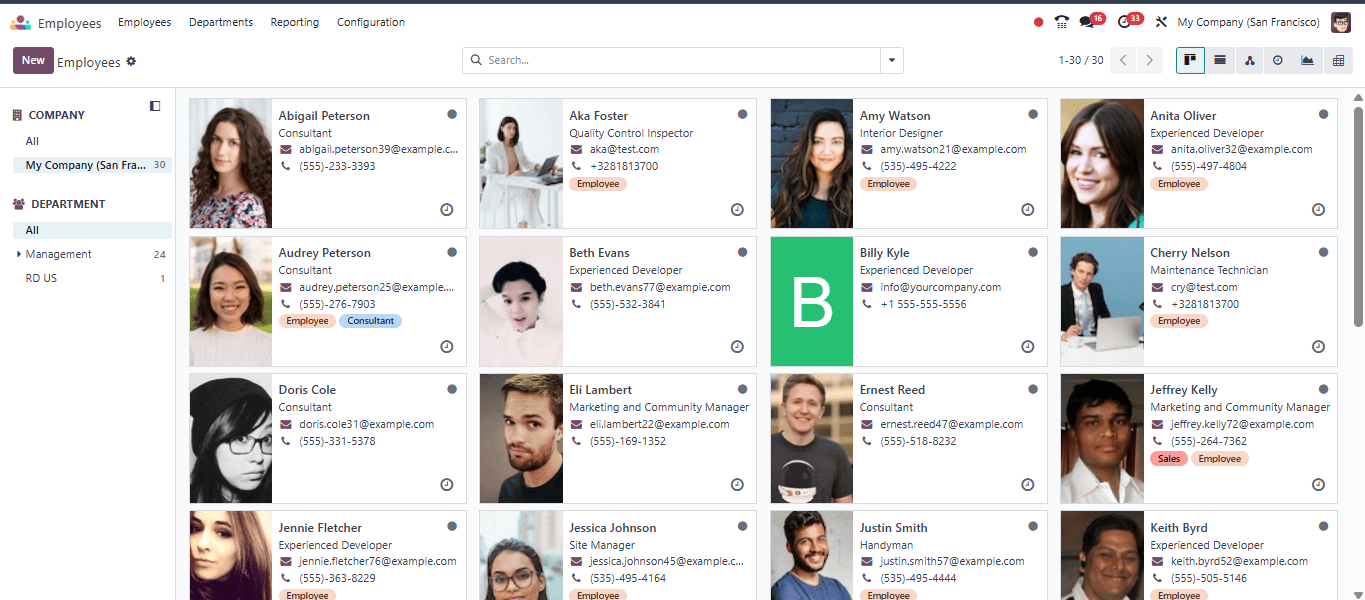
Once you click the “New” button, you’re taken to the employee profile form. The top section of the form — placed above the set of notebook tabs — serves as a summary of the employee’s core work details. This area is split into two parts: the left-hand side primarily covers contact and categorization, while the right-hand side focuses on job structure and reporting hierarchy.
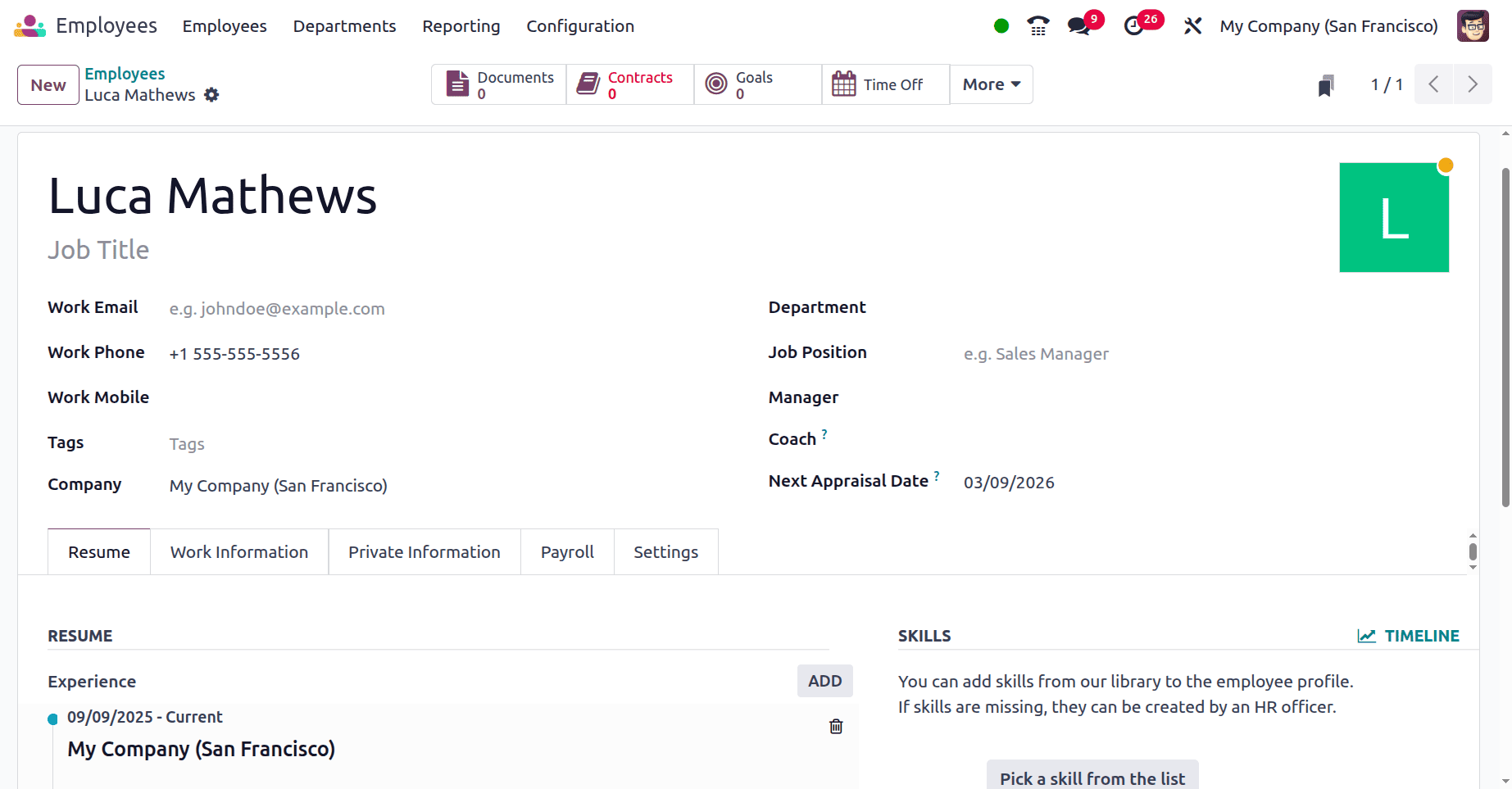
On the left side, you can enter the employee’s work email, which is used for internal communication within the company. Below that, the fields for work phone and work mobile allow you to register the employee’s official contact numbers. These details ensure that all communication channels are well-documented and accessible to HR, managers, and team members. The tags field lets you assign labels to the employee — for example, “Sales,” “Employee,” “Consultant,” or any custom tag your organization uses. Tags are extremely useful for quick filtering, organizing, and grouping employees across departments or roles.
On the right side, you’ll find the employee’s department and job position, which help define where they sit within the organization. You can assign a manager for the employee, which not only helps in reporting but also plays a key role in generating the organizational chart later. There’s also an optional coach field, used to designate a mentor or supervisor — especially useful in onboarding or training scenarios. Lastly, the next appraisal date can be set, helping HR teams schedule timely performance reviews and ensure that the employee’s growth is regularly evaluated.
Now that we’ve explored the main employee form fields, let’s move on to the notebook tabs section found below. These tabs provide more detailed information about the employee’s background, personal data, and work-related settings.
The first tab we’ll look at is the Resume tab.
The Resume tab in the Employee form is used to track an employee’s professional background, including their past roles and relevant skills. It provides a structured view of their work history and capabilities, which can be especially helpful during evaluations, promotions, or project assignments.

To add a new experience entry, click the “Add” button under the Experience section. This opens a pop-up wizard where you can enter details such as the title (e.g., Sales Consultant), duration, and type of experience.
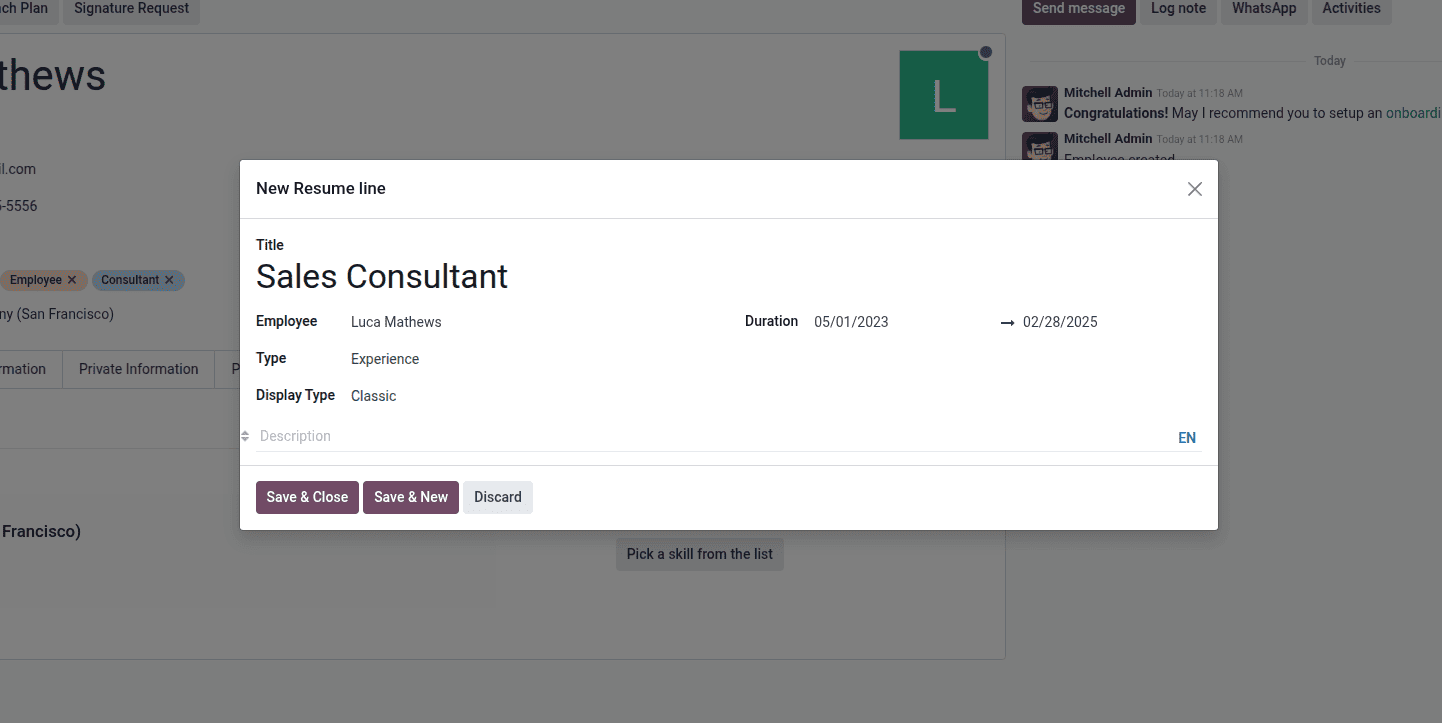
You can also choose the display type, which determines how the experience is shown in the profile. Clicking on the Save & New will create an experience under the Resume section. We can choose a variety of types such as education, experience, side projects, social media etc.
Next to the resume section, we can add skills by clicking the Add button. Clicking on it, will open a popup wizard where you can enter the details about your skill.
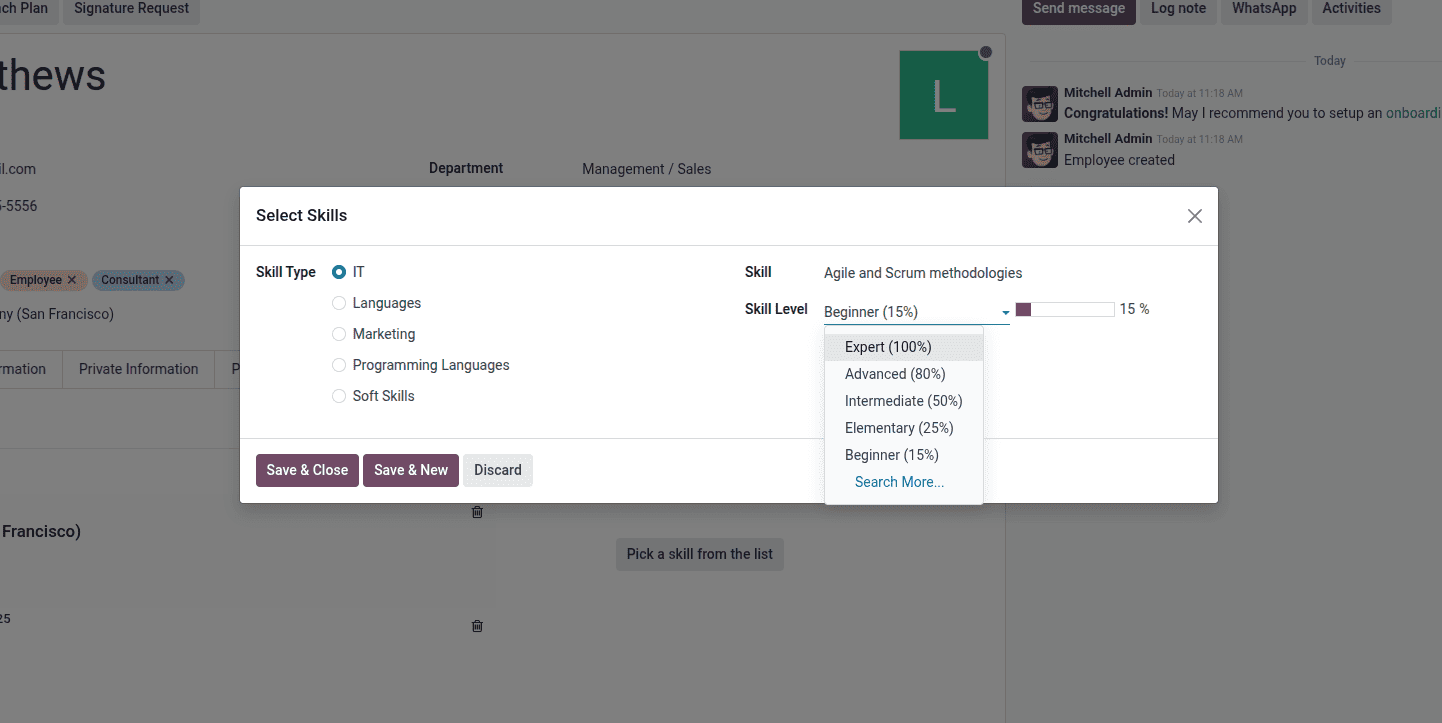
Here, you will be able to choose the skill type, corresponding to the type you’ve chosen. It will show the skills and the skill levels associated with it.
Once saved, the new entry appears in a timeline format under the Resume section.
Next, we dive into the Work Information tab. This section is particularly important for administrative and operational clarity. The first field you’ll notice here is Location. It typically represents the employee's assigned branch or office—for example, “My Company: San Francisco”. This helps HR and managers understand where the employee is officially based.

Following that, we come across the Approvers section. Here, we define the managers responsible for approving various requests made by the employee—be it Expenses, Time Off, Timesheets, or Attendance. Setting the right approvers ensures that workflows run smoothly and that there’s always someone accountable for verifying entries.
Scrolling further, we arrive at the Remote Work section. Here, you can configure the employee’s default work location for each day of the week. Whether they’re working from home, in-office, or at a client location, it’s all tracked right here. The defined locations automatically repeat every week unless updated, making it especially useful in hybrid work setups where teams are spread across different locations.
Lastly, under the Schedule section, you’ll find options to set the employee’s working hours—such as a 40-hour week—and the applicable time zone. This schedule not only keeps attendance accurate but also syncs with other modules like Planning and Timesheets.
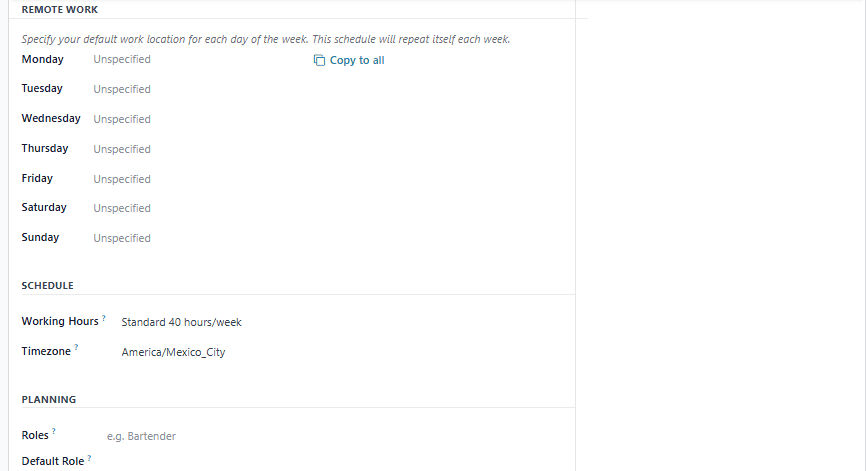
At the bottom of this section, there’s the Planning Role field. It allows you to assign a role that will reflect in the Planning module—like assigning a Consultant, Server, or Bartender depending on the nature of the job.
Lastly, right next to the other options like Location, Approvers, Remote Work, and Schedule, there's a valuable feature called the Organization Chart. This visual representation helps you quickly understand the reporting structure within the company.
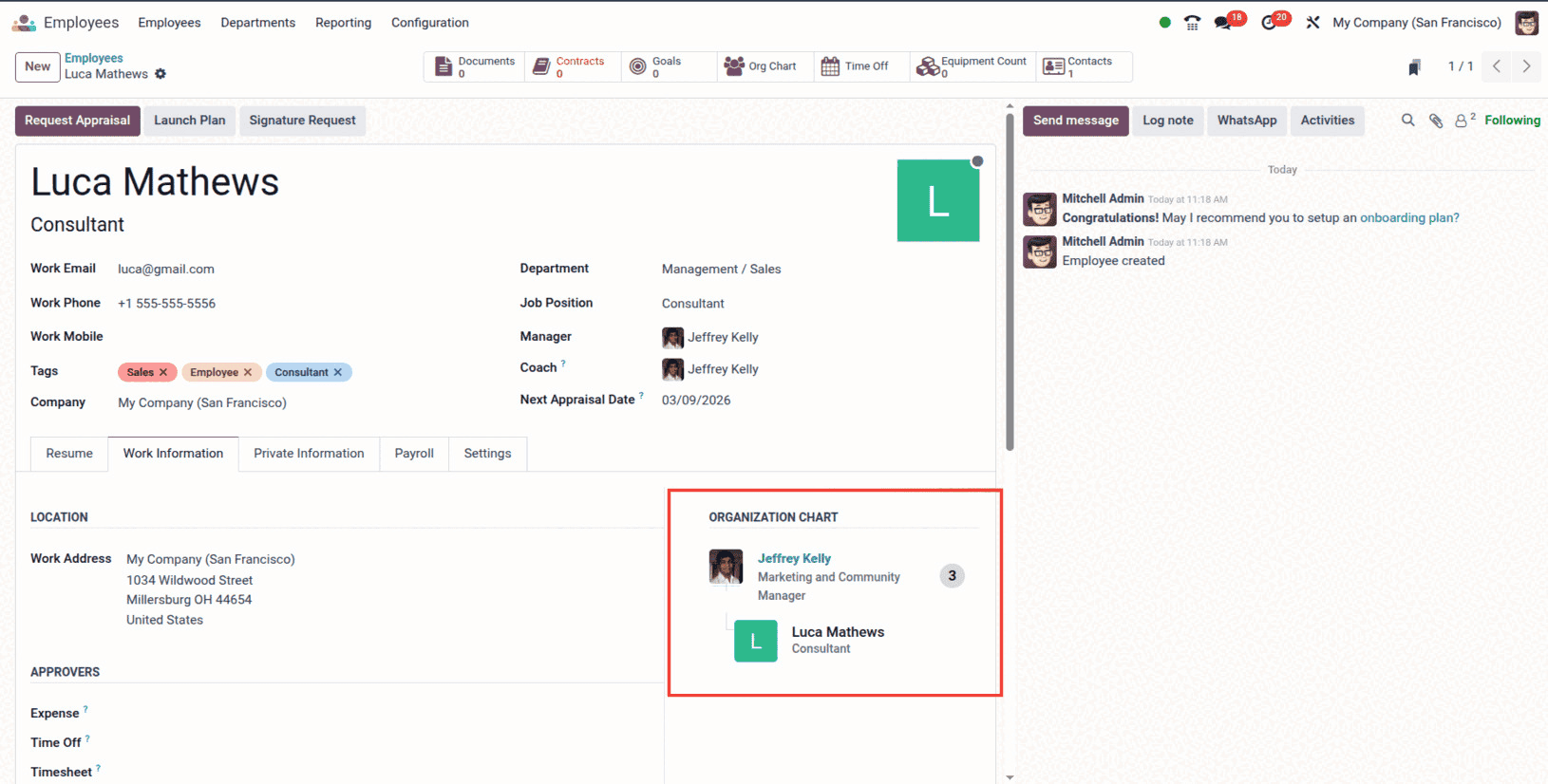
In the above view, you can see a clear hierarchy—Jeffrey Kelly, the Marketing and Community Manager, is shown as the supervisor, and Luca Mathews as a Consultant reporting to him.

In the expanded view, the chart becomes even more informative. It displays all the team members reporting to Jeffrey Kelly, including Luca Mathews, Eli Lambert, and Rachel Perry. This layout makes it easy to grasp team composition and roles at a glance.
The org chart is especially helpful for new employees or large teams where understanding reporting lines is essential.
Moving forward with managing employee data, the Private Information tab within an employee's profile is where all sensitive and personal details are securely stored.
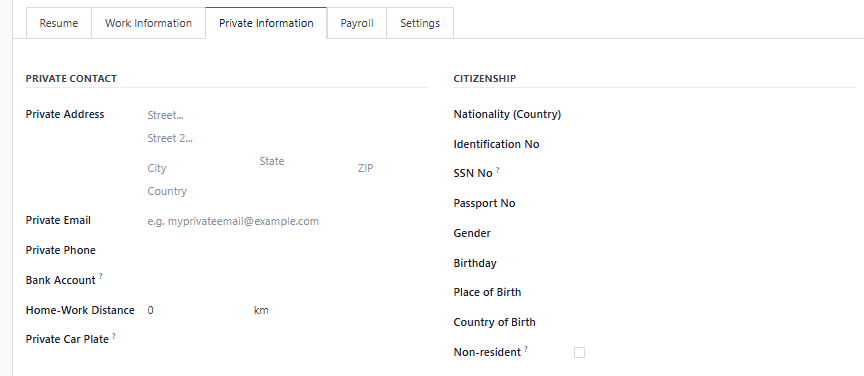
This tab is broadly divided into several key areas:
Private Contact and Address: This section handles the employee's personal residential address and private contact details like personal email and phone numbers, kept separate from their work contacts.
Citizenship Information: For compliance, this includes fields for Nationality, Identification No., and Passport No.
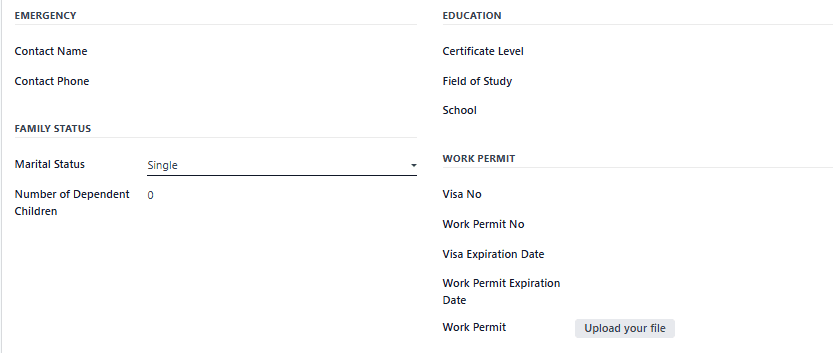
Emergency Contact Details: A vital safety feature, this area allows you to record the name and phone number of a person to be contacted in case of an employee emergency.
Personal and Marital Status Details: This covers fundamental personal data such as Gender, Birthday, Place and Country of Birth, Marital Status, and the Number of Dependent Children.
Work Permit Documentation: Crucial for employees requiring specific permits, this section tracks Visa No., Work Permit No., their respective Expiration Dates, and allows for attaching the Work Permit Document itself.
Educational Background: This provides space to note the employee's Certificate Level, Field of Study, and the School or institution attended.
The next tab is Payroll, within an employee's profile, is where all the financial details related to their compensation and salary processing are managed.

It begins with the employee’s legal name and preferred payslip language, followed by their unique registration number. The federal and state tax filing statuses help determine the appropriate withholding amounts, along with fields for allowances, extra withholdings, and any disability status that may affect tax calculations.
Further below, we come across details related to the W-4 form, such as multiple job declarations, dependents, other income, deductions, and any additional withholdings. These entries ensure that the employee’s tax withholdings are accurate and up to date. Overall, this tab serves as the backbone for processing salaries while ensuring compliance with payroll regulations.
At last in the employee form, we have a settings tab.

The Settings tab plays a crucial role in defining the employee’s technical and operational configurations. Under the Status section, you can specify the employee type — whether they're a regular employee, a freelancer, or another category. You can also link the employee to a system user through the "Related User" field, which is especially useful for assigning access rights across modules like Attendance, Point of Sale, or Manufacturing. Additional identifiers like PIN Code and Badge ID help facilitate quick authentication and tracking within the system.
In the Application Settings section, you'll find fields such as Hourly Cost, which helps in cost forecasting and payroll planning. Lastly, there's the option to assign a Fleet Mobility Card, which becomes relevant if the employee is involved in company vehicle usage or fleet operations.
Adding Bank Details in Odoo 18
Odoo 18 introduces a more organized approach to managing employee bank details by placing them under a dedicated submenu. To add or manage bank information, navigate to the Employees main menu and select Bank Accounts.
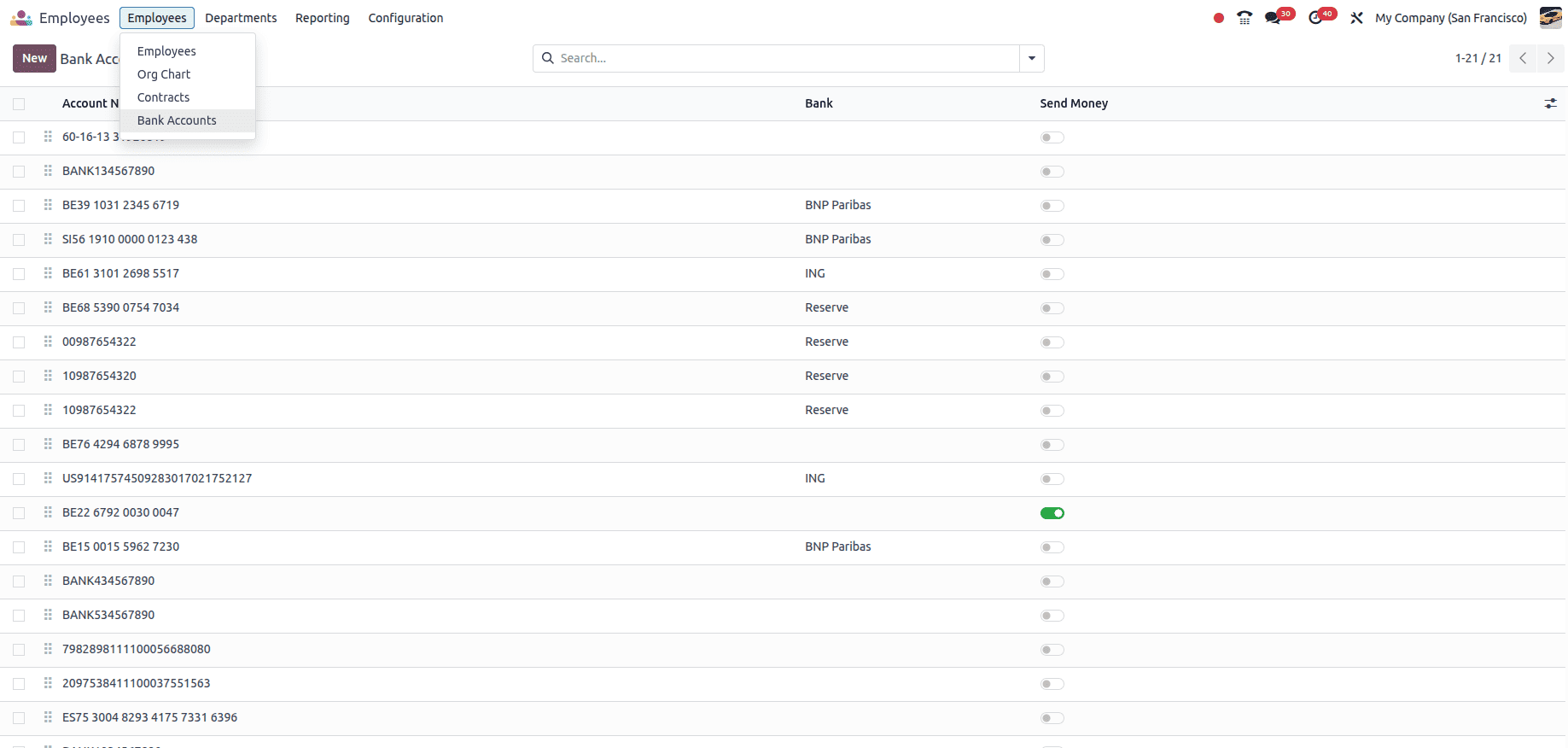
This section lists all saved employee bank details in one view. To add a new account, click the New button.
In the bank account form, you’ll find fields like Account Number, Bank, ABA/Routing, and Account Holder. You can also assign the Company, define the Currency, and enable the Send Money toggle if the account is used for payroll disbursement.

The status (Trusted/Untrusted) helps indicate whether the account is verified for transfers. This structured layout ensures every detail required for payroll operations is securely stored and easily accessible.
Managing Employee Contracts in Odoo 18
Odoo 18 simplifies contract management through a dedicated Contracts submenu under the Employees main menu.
To create a new contract, simply click the New button. This opens a detailed contract form where you can link it to a specific employee, define the job position, set the contract duration, salary structure, working schedule, and other employment terms.
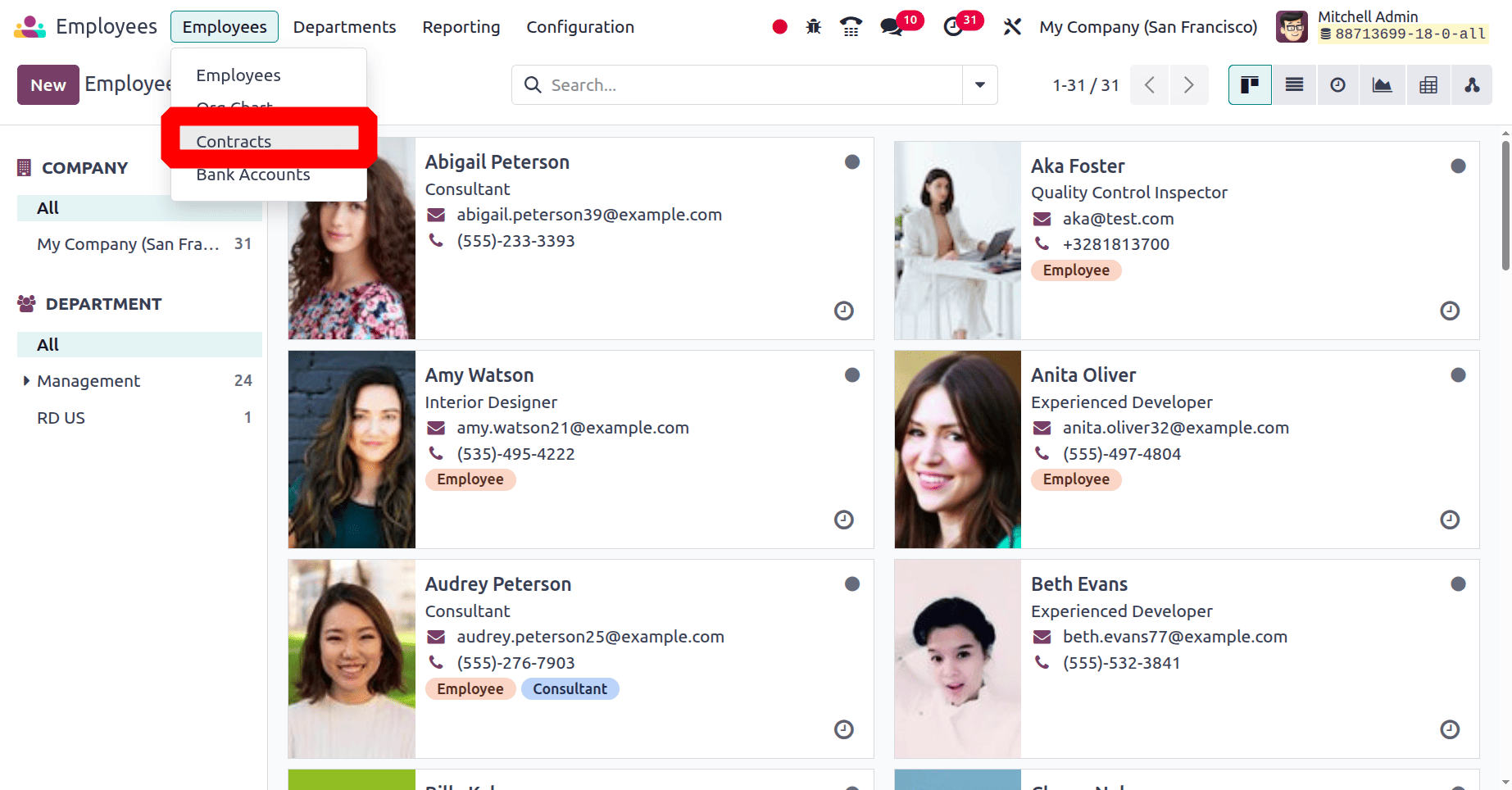
Once you click the New button in the Contracts section, you’ll be taken to a detailed contract form where you can define all the essential terms of employment. At the top of the form, you can select the Employee the contract is associated with and specify the Contract Start Date and optionally an End Date.

You also have the ability to choose the Working Schedule (e.g., standard 40 hours/week), along with the Work Entry Source—which determines whether the work logs are calculated based on a fixed schedule, actual attendances, or planned shifts. On the right-hand side, you'll fill in additional details like the Salary Structure Type, Department, Job Position, and Contract Type. Furthermore, fields like Wage on Payroll and HR Responsible allow you to assign the salary amount and designate the HR officer managing the contract.
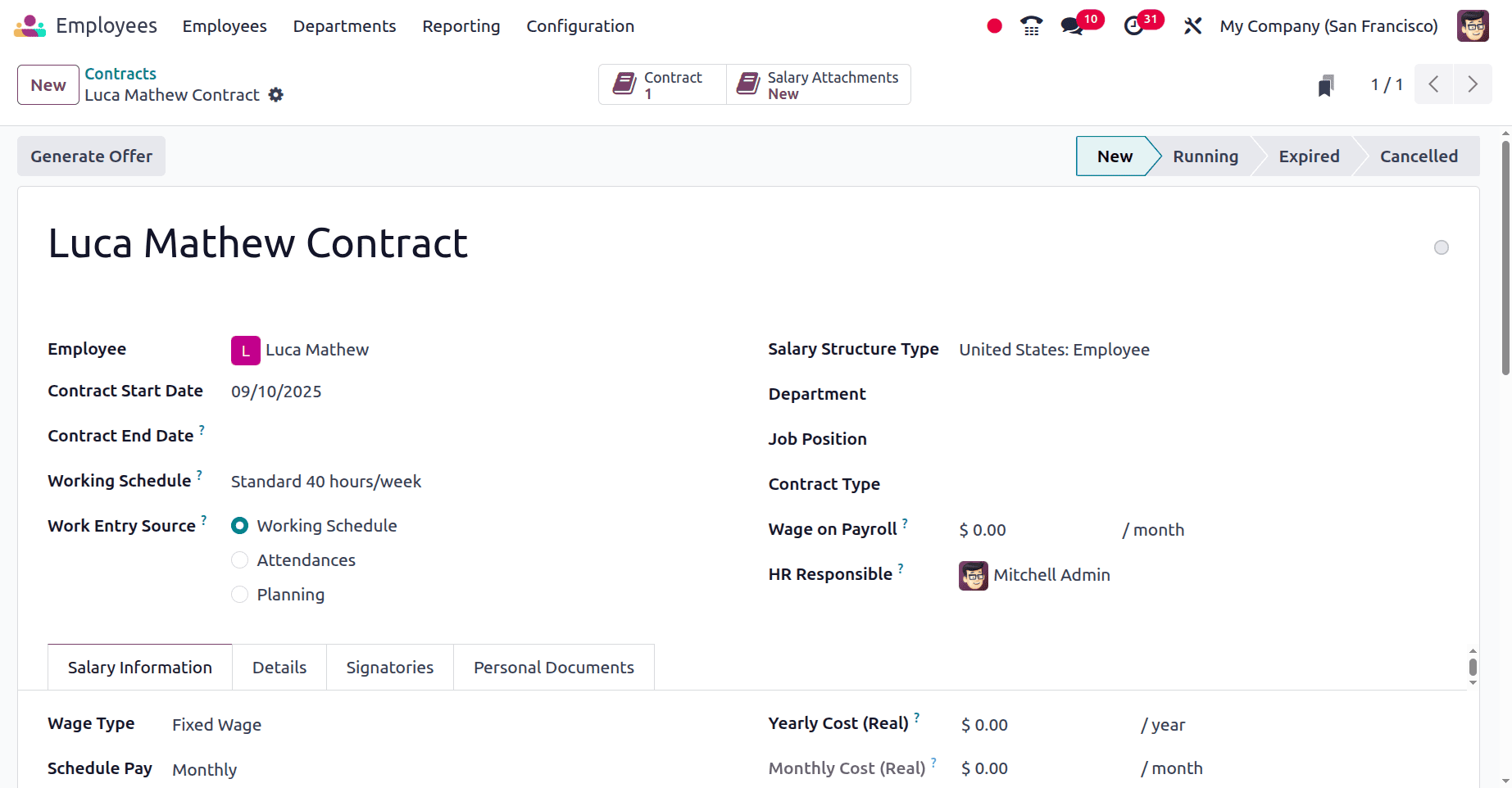
In Odoo 18, the Salary Information tab of the contract form displays essential payroll-related details. It includes the wage type (such as fixed wage), payment frequency (like monthly), and the base wage amount. It also calculates the yearly and monthly cost to the company, giving a clear financial overview. Additionally, this section covers Pre-Tax Benefits like 401(k) plans, employer matching contributions, and health benefits per payslip. On the other hand, Post-Tax Deductions such as ROTH 401(k) are defined, helping organizations manage and reflect the total compensation structure of the employee.
If the employee wage is updated, according to that the Yearly Cost and Monthly cost will be updated automatically there.

Alongside this, the Details tab provides additional contract configurations such as selecting a predefined contract template, linking the contract to an originated job offer, and assigning an analytic account for cost tracking. It also allows specifying part-time status and adding notes for special conditions, ensuring flexibility and detailed record-keeping.
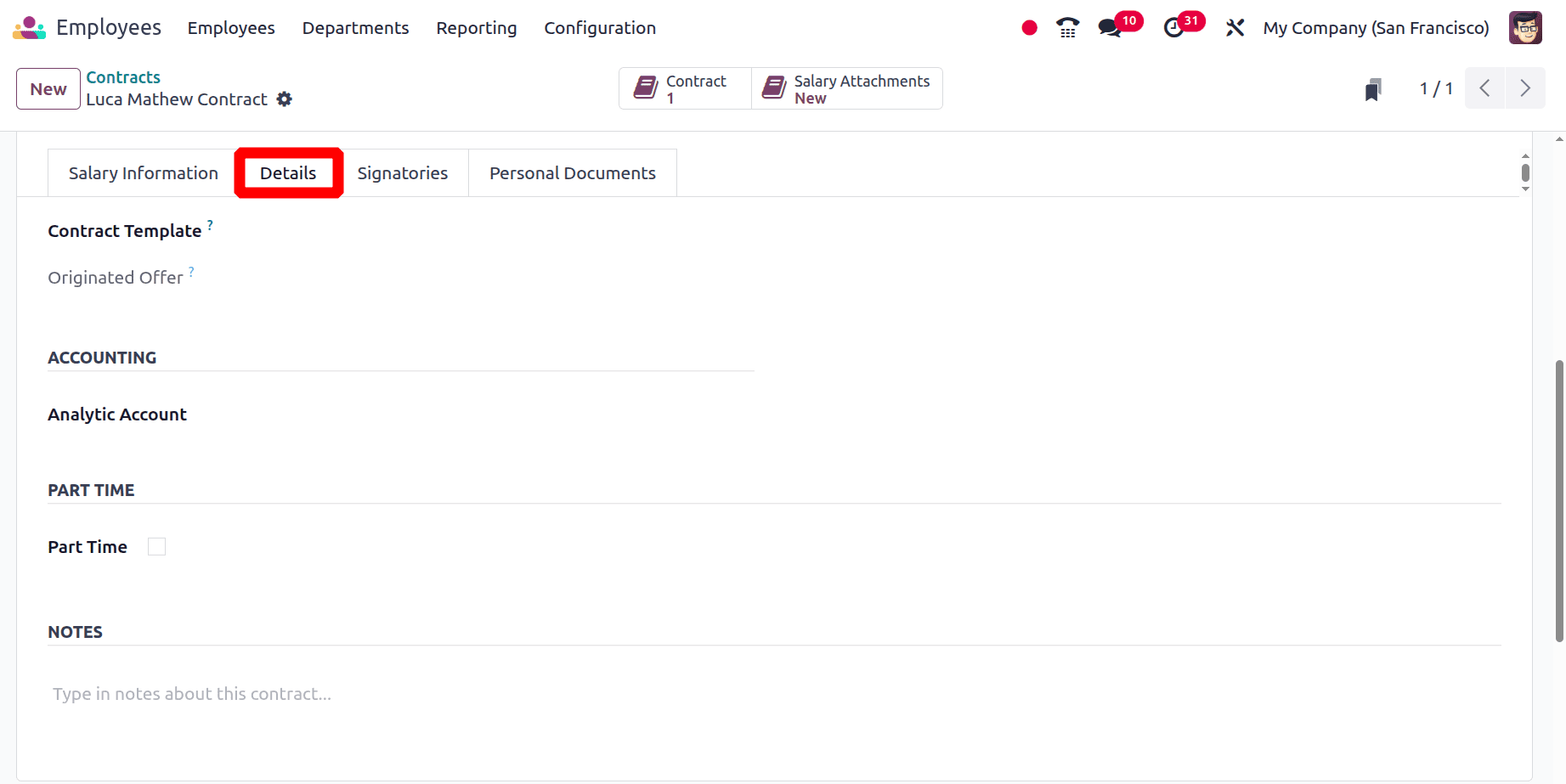
The Signatories tab specifies the parties responsible for validating the contract. Typically, this includes the employee and an authorized company representative, such as an HR manager or department head.
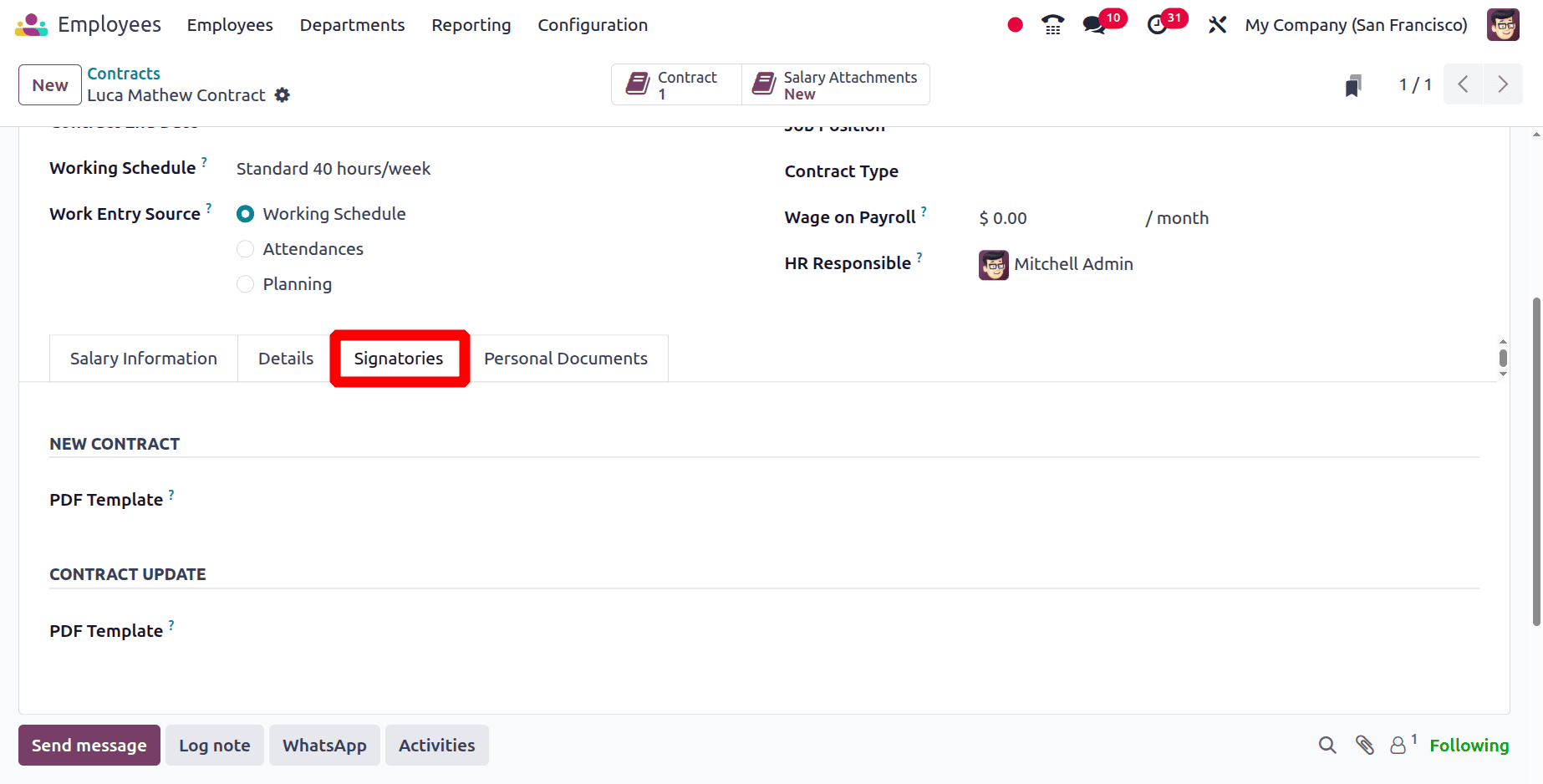
Adding signatories ensures accountability, legal compliance, and a clear record of who has formally approved the employment agreement.
The Personal Documents tab allows attaching essential files related to the employee, such as ID card copies, mobile and internet subscription invoices, or SIM card copies.
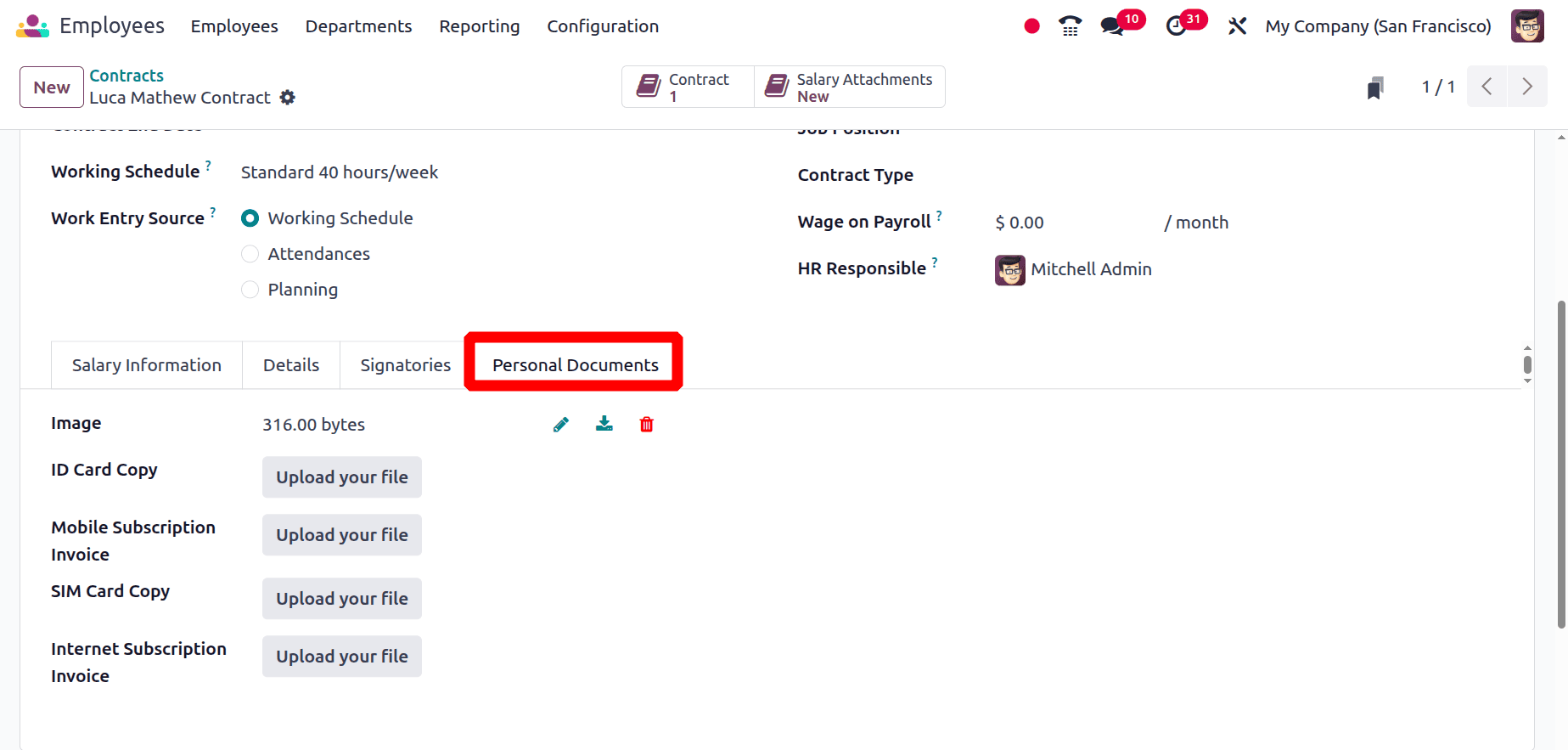
These uploads ensure proper documentation and quick reference for HR, while keeping all relevant records organized within the contract for compliance and future verification.
After filling out all the necessary details, users can view a status bar that reflects the contract’s stage. The New status indicates the contract is created but not yet active. Running shows the contract is currently in effect. Expired appears once the end date is passed, while Cancelled applies to contracts terminated before completion.
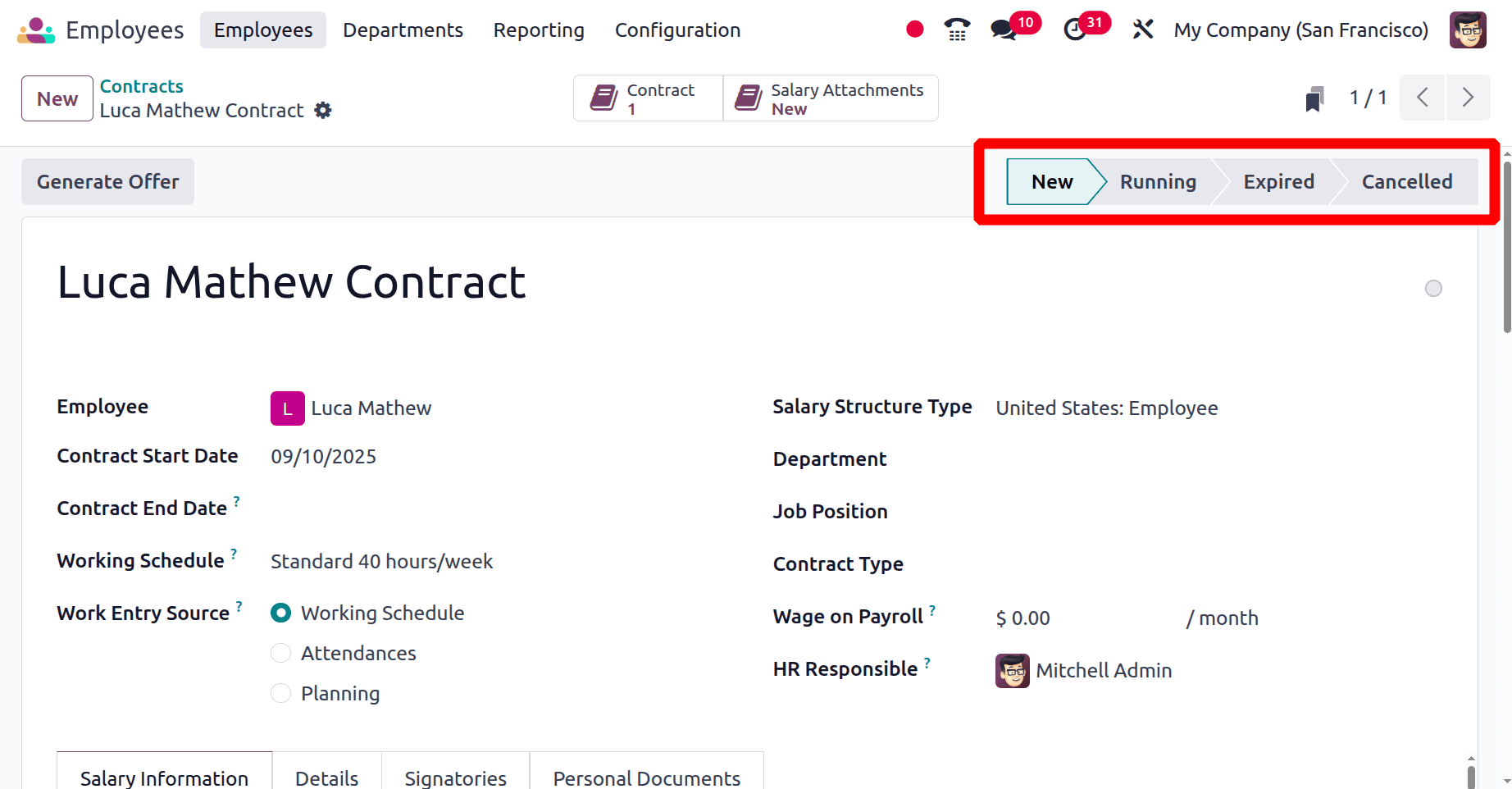
After creating an employee in Odoo, a Contract smart button becomes visible in the employee’s form view.
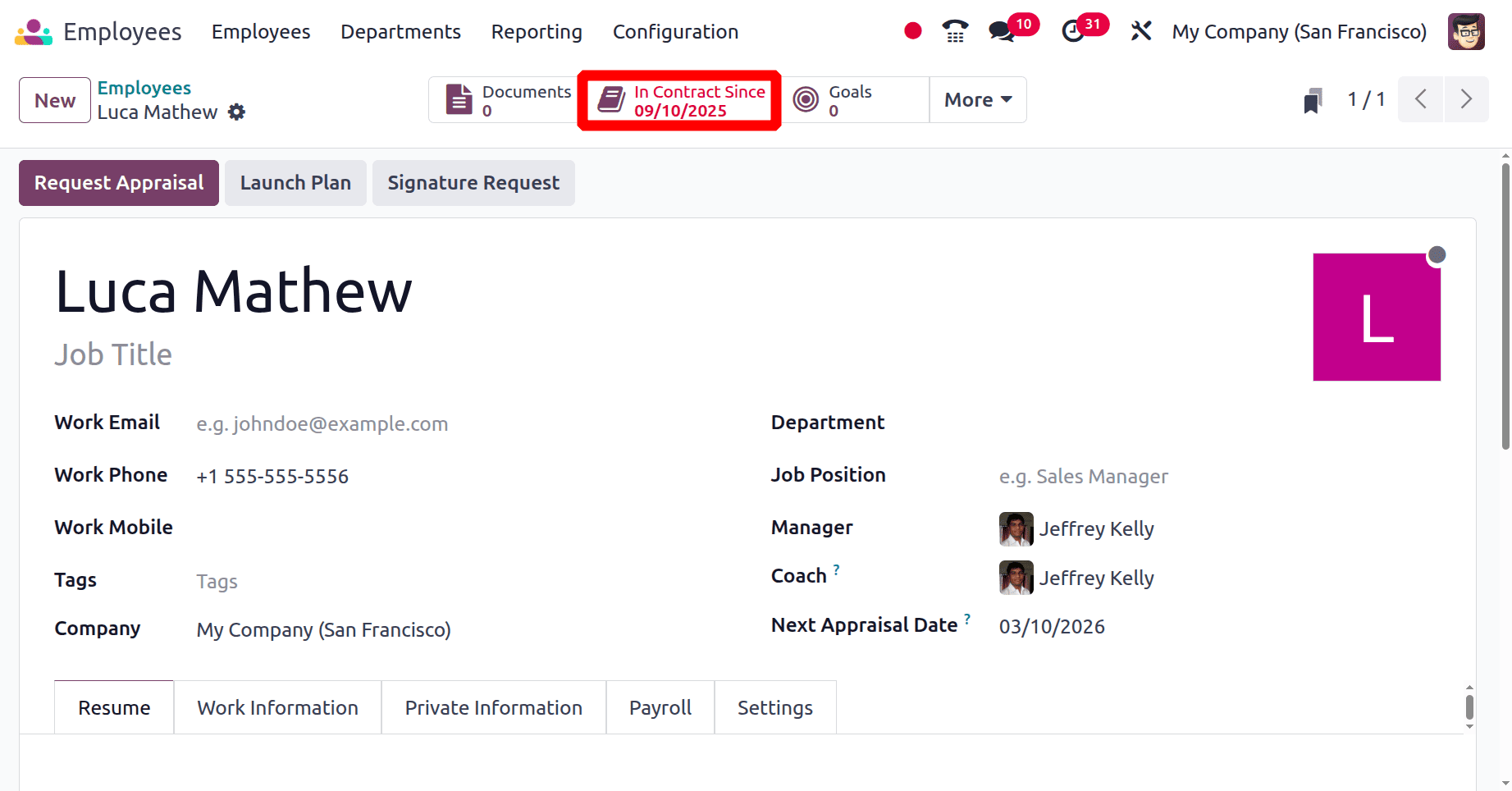
This smart tab offers quick access to the employment contract linked to that specific employee. It displays key details such as the contract name and its start date at a glance. By clicking on it, users are redirected to the contract form, where all the related employment information — like working schedule, salary structure, job position, and wage details — can be viewed or edited.
The contract is in New stage currently. If it is in the Running stage, the smart tab shows in Green colour as shown in the below screenshot.
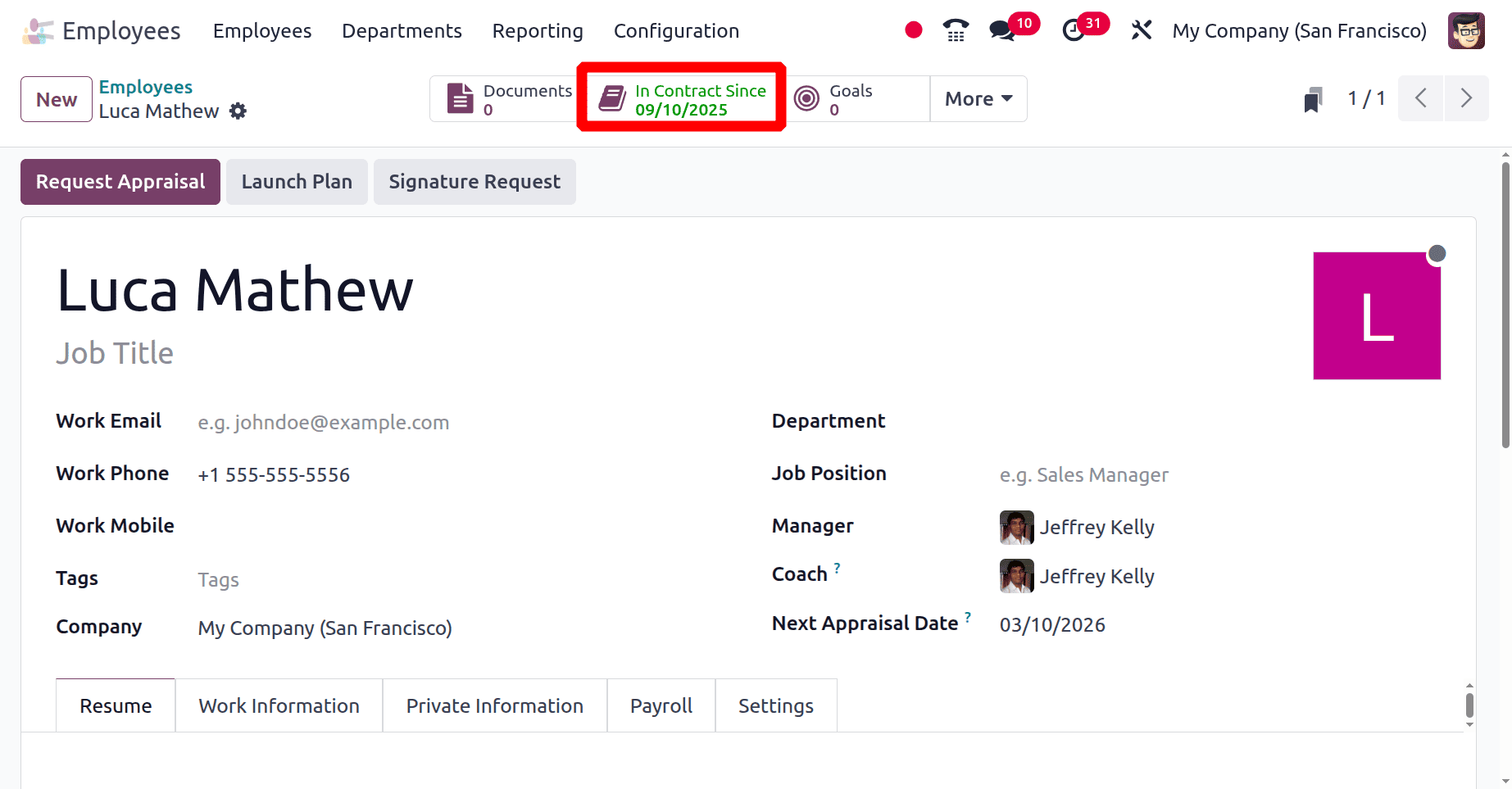
Contract Templates in Odoo 18
In Odoo, contract templates streamline the process of creating employee contracts by predefining commonly used settings. These templates can be accessed through the Configuration menu under the Templates submenu.

Upon selecting a template, users are presented with a form view similar to a regular employee contract.
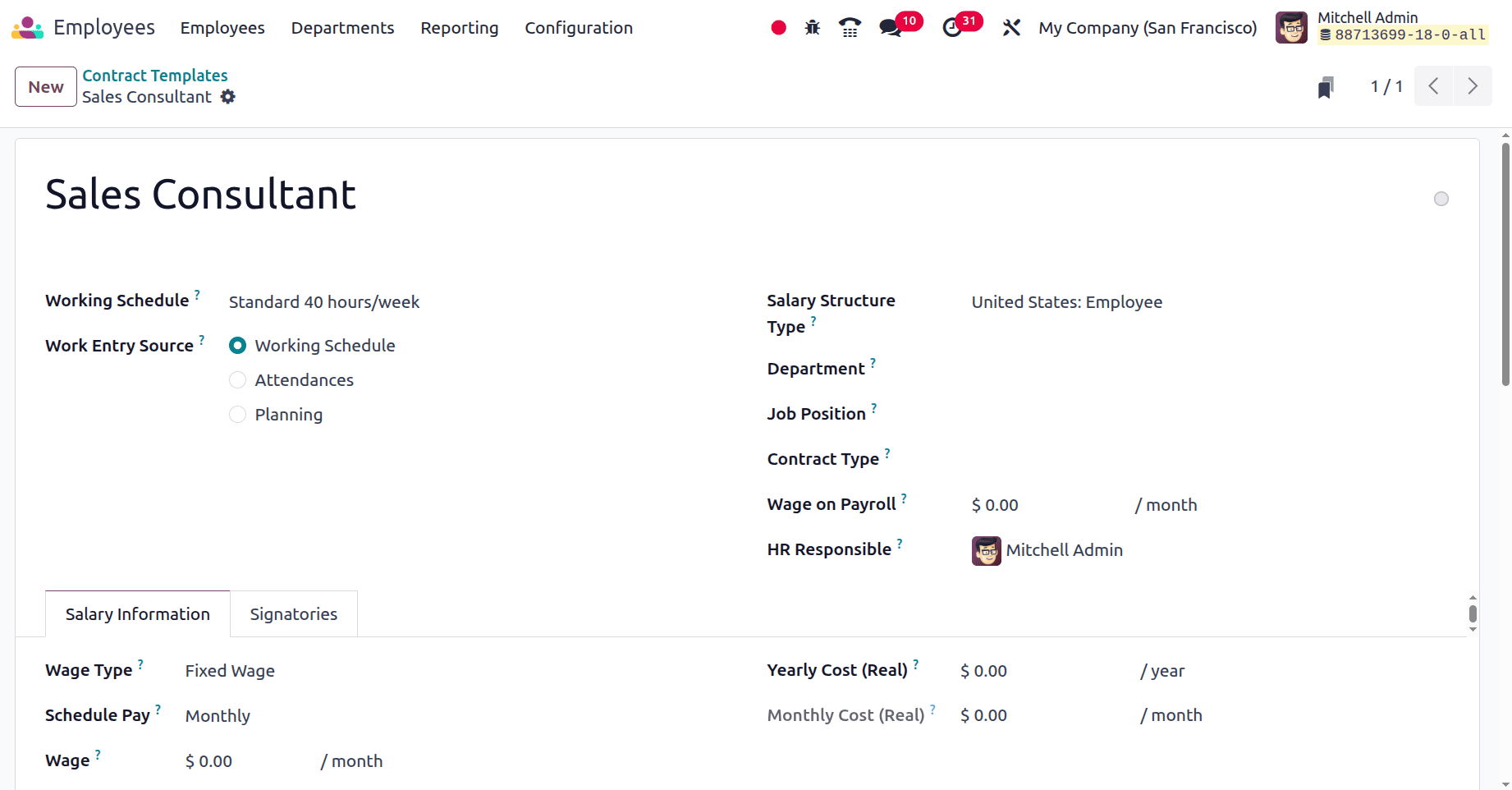
Each template includes fields such as Working Schedule, Salary Structure Type, Job Position, Contract Type, and HR Responsible, along with wage details, pre-tax benefits (like 401(k) and medical plans), and post-tax deductions (such as ROTH 401(k)). Additionally, it has notebook tabs like Salary Information and Signatories to structure the data.

By using these templates during contract creation, companies can ensure consistency and save time when onboarding multiple employees for similar roles.
Salary Package Configurator in Odoo18
When it comes to offering a competitive and transparent salary package, Odoo’s Salary Package Configurator is an incredibly powerful tool. Though not part of the Employees module directly, it can be accessed through the Payroll application under Configuration > Salary Package Configurator.

This feature allows companies to design and control what prospective employees see when they apply for a job, and how salaries and benefits are calculated based on their inputs.
The configurator is divided into three important sections: Benefits, Personal Info, and Resumé—each contributing to building a comprehensive salary offer that reflects the values and policies of the organization.
Benefits
One of the most appealing aspects of any job offer is the benefits that come along with the salary. Odoo allows companies to configure various types of benefits depending on the employee’s salary structure type. For example, a full-time employee might be eligible for a company car or internet reimbursement, while an intern may only be entitled to meal vouchers.
To view or manage these benefits, navigate to:
Payroll > Configuration > Salary Package Configurator > Benefits

You can configure whether a benefit affects the net salary, whether it’s a monthly cash amount, a non-financial perk, or a yearly bonus, and even request documents from the employee before approving the benefit.
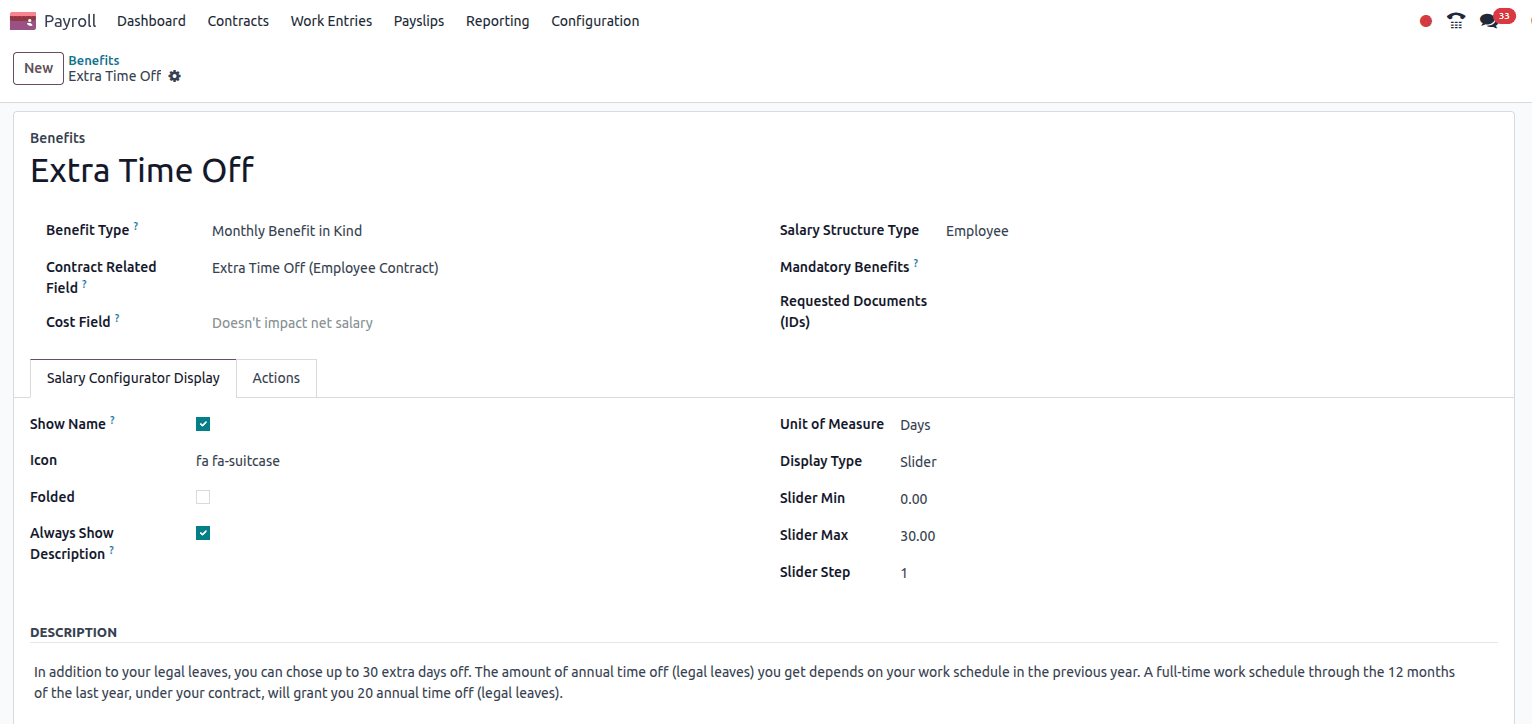
You’ll also be able to define how the benefit appears in the configurator—whether it's a dropdown, a radio button, or a manual input field. Some benefits can be “folded,” meaning they only appear when certain other benefits are selected.
Additionally, Odoo allows automated activity assignment, such as creating a follow-up task or assigning a signature request, once a specific benefit is chosen. This level of automation ensures a smooth onboarding process with minimal manual effort.
Personal Info
The Personal Info section in the Salary Package Configurator determines what fields appear in that form.
You can find this section at:
Payroll > Configuration > Salary Package Configurator > Personal Info
Each entry here is linked to a related model (e.g., Employee or Bank Account) and a related field that tells Odoo where to store the data. For example, if you want to capture an emergency contact number, you’d link it to the corresponding backend field on the employee model.
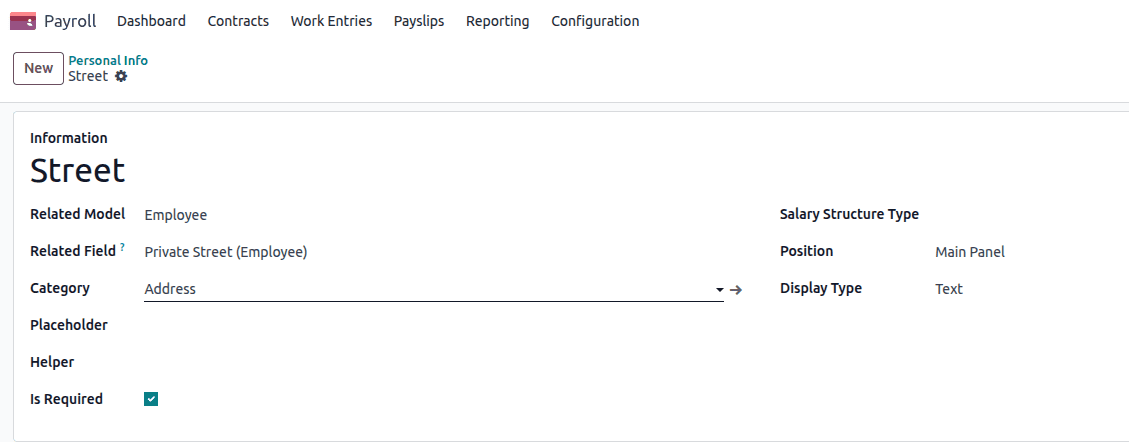
Display settings allow you to choose how the field appears—text box, checkbox, document upload, radio button, etc. You can also make fields required, ensuring that the employee can’t complete the salary configurator without submitting critical information.
This ensures that HR gets all the needed information right from the start—making the transition from applicant to employee seamless.
Resumé
The Resumé section doesn’t refer to the candidate’s CV—it defines the salary computation rules that appear when a job offer is generated.
Access it via:
Payroll > Configuration > Salary Package Configurator > Resumé
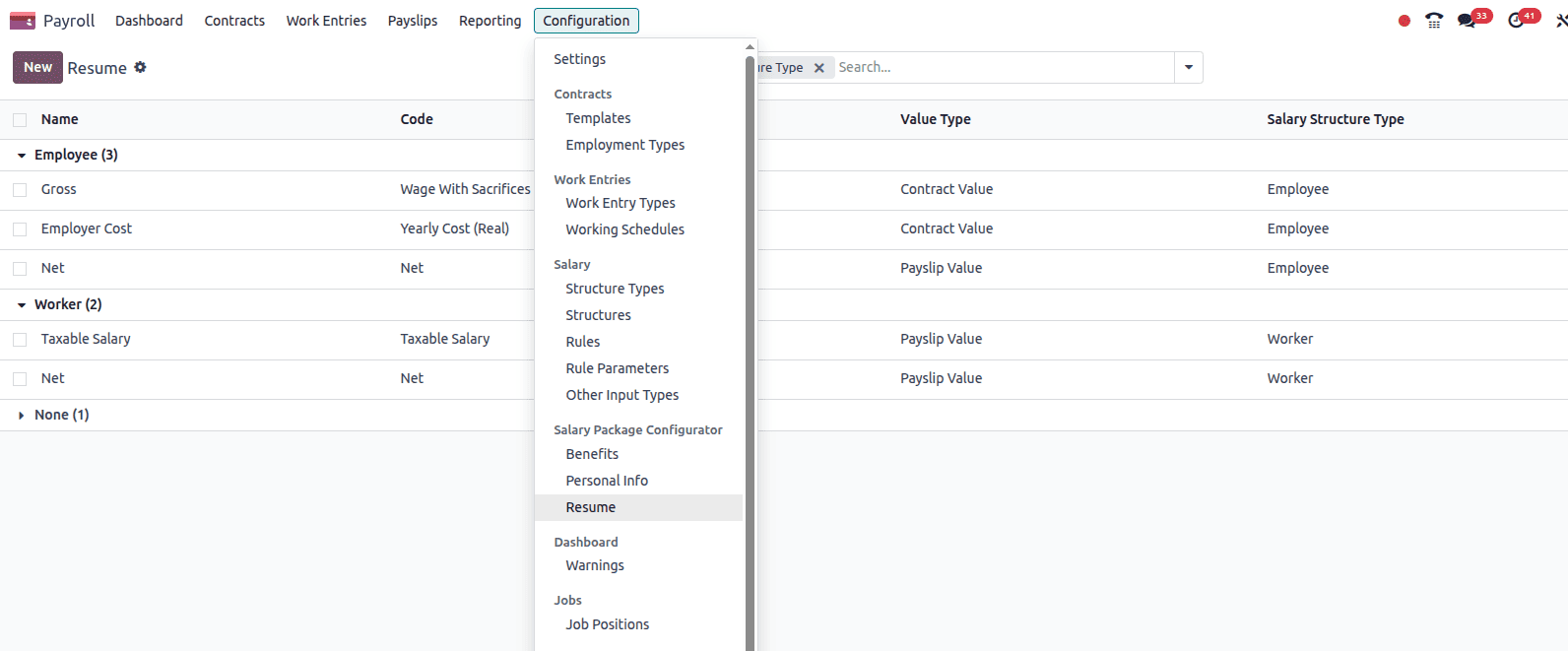
Each entry here belongs to a salary structure type like "Employee", "Worker", or "Intern" and is grouped under categories such as Monthly Salary, Yearly Benefits, or Total. These categories define how different components of the package are summed up and displayed.

For each rule, you can specify whether it impacts the monthly total, its unit of measure (currency, percentage, or days), and how the value is calculated—whether it’s fixed, based on benefits, taken from the contract, or computed from a payslip.
This is where the actual offer values are calculated, which means accuracy and clarity are essential. By properly configuring this section, businesses ensure candidates see the right numbers and have no confusion about what they're being offered.
The Salary Package Configurator in Odoo isn’t just a tool for HR—it's a bridge between what a company offers and what a candidate sees.
Extra Time Off Allocation in odoo18
In Odoo, HR configuration is all about streamlining employee onboarding and reducing manual tasks. One such automation is the Extra Time Off Allocation setting available in the Employee module configuration.
Go to: Employees > Configuration > Settings Here, under the section labeled Extra Time Off Allocation, you’ll find an option:

By enabling this option, Odoo will automatically generate a time off allocation request if the employee selects extra time off during the salary package configuration process.
You also get to define the Time Off Type — this could be "Extra Paid Leaves", "Unpaid Time Off", or any custom time off category your company uses.
When candidates or employees use the Salary Package Configurator and choose additional leave days as a part of their offer (which might reduce salary or be deducted differently), you won’t have to manually create a time off allocation. Odoo will handle it for you, keeping HR workflows consistent and fast.
Odoo 18 offers a comprehensive solution for managing employee data effectively. It allows HR teams to define and organize all essential employee details, including personal information, payroll data, contracts, and settings. Bank details can now be added through a dedicated submenu, and the organizational chart provides clear visibility of company structure. The system also supports the creation of contract templates, configuring salary packages, and automating extra time off allocation. Each field is purposefully designed for clarity and accuracy. By connecting these features across modules, Odoo streamlines HR operations and simplifies the overall employee management experience within the organization.
To read more about Overview of Reporting in Odoo 18 Employee, refer to our blog Overview of Reporting in Odoo 18 Employee.